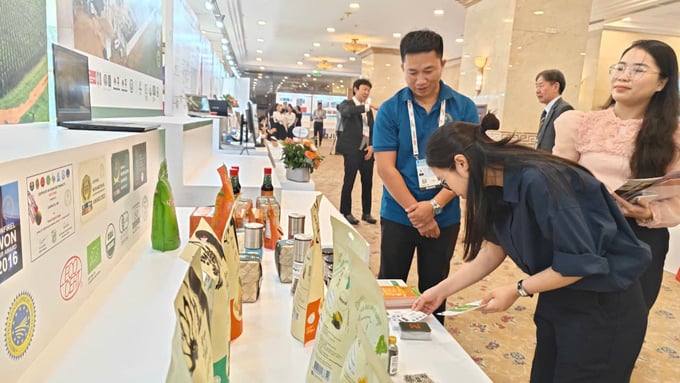November 18, 2025 | 23:44 GMT +7
November 18, 2025 | 23:44 GMT +7
Hotline: 0913.378.918
November 18, 2025 | 23:44 GMT +7
Hotline: 0913.378.918

Nguyen Quy Duong, Deputy Director of the Department of Crop Production and Plant Protection, Ministry of Agriculture and Environment. Photo: X.A.
On the morning of March 3, in Ho Chi Minh City, the Vietnam Pepper and Spice Association (VPSA) held the opening ceremony of the Vietnam International Pepper and Spice Outlook 2025 (VIPO 2025), with the sponsorship of the Ministry of Agriculture and Environment, the Trade Promotion Agency (Ministry of Industry and Trade).The conference gathered the participation of more than 300 delegates, including experts, production and export enterprises, farmers, and representatives of local authorities.Of which, 51% of the attendees were international from leading associations of India, China... and 40% were buyers, promising to create a vibrant trading playground.The event began a series of activities to promote industry development and expand cooperation opportunities for pepper and spice exporting enterprises.Speaking at the opening ceremony, Nguyen Quy Duong, Deputy Director of the Department of Crop Production and Plant Protection, Ministry of Agriculture and Environment, emphasized that Vietnam is blessed with favorable climate and soil conditions, creating a solid foundation for the cultivation of industrial crops, fruit trees and especially pepper.
According to statistics, by the end of 2024, the pepper growing area will reach 110,500 hectares with an average yield of 260 kg per hectare, double the global average (127 kg per hectare), and an output of about 200,000 tons.
In 2024, pepper export turnover reached USD 1.32 billion. Notably, the pepper growing area is only about 15% of the coffee growing area and 12% of the rubber growing area. Still, it contributes about 23% of the coffee export value (USD 5.6 billion) and more than 38% of the rubber export value (USD 3.4 billion), opening up great development potential if the industry is adequately exploited.

Pepper and spice businesses participate in product display and introduction. Photo: X.A.
In addition, Vietnam is also a leader in the production and export of other spices such as cinnamon (nearly 200,000 hectares, accounting for about 20% of the global cinnamon growing area); anise (55,000 hectares, second in the world after China); other spices: ginger, turmeric,... serving domestic demand and many international markets. Mr. Nguyen Quy Duong said that the context of increasing demand for natural and organic spices in the world opens up many opportunities for Vietnamese enterprises to develop in a sustainable direction and increase domestic value.
Hoang Thi Lien, Chairwoman of VPSA, affirmed that the Vietnamese pepper and spice industry still maintains an essential position in the global market when Vietnam accounts for about 40% of total output and nearly 55% of the world's pepper export turnover. However, fluctuations from climate, political conflicts and trade wars also require strict risk management for the industry's supply chain.
VIPO 2025 has been taking place until March 5 with in-depth discussions on sustainable development and risk management. At the same time, it is an opportunity for businesses to display products, promote trade and affirm the economic value of Vietnamese spices in the international market.

Memorandum of Understanding signing ceremony between VPSA and China Spices Association. Photo: X.A.
On this occasion, the Vietnam Pepper and Spice Association and the China Spice Association signed a memorandum of understanding on cooperation in the sustainable development of the Vietnamese pepper industry.
Mike Liu, Chairman of the China Spice Association, said that 20 Chinese enterprises participated in this event to seek cooperation opportunities with Vietnamese enterprises from production to export. From there, together with the Vietnam Pepper and Spice Association, we will bring pepper in particular and Vietnamese spices in general to the world.
Orientation for pepper development by 2030, the adjusted area will be about 80,000-100,000 hectares, the yield will be 240-250 kg per hectare, the output will be about 200-230 thousand tons.
By 2030, strive for about 40% of pepper growing area to meet GAP standards and equivalent; about 40-50% of pepper growing area will be granted a production unit code with product traceability. The area for replanting and improving varieties with new high-quality varieties will be about 40-50%;
Develop pepper growing areas according to organic standards and other standards such as VietGAP, GlobalGAP in key production areas such as Dak Nong, Dak Lak, Binh Phuoc, Gia Lai, Dong Nai, Ba Ria - Vung Tau and other provinces such as Lam Dong, Quang Tri; By 2030, the organic pepper area will reach 5,000 hectares, accounting for 5% of the pepper area.
Translated by Huong Giang

(VAN) 'If we can address disease challenges and properly plan farming zones, Vietnamese shrimp can absolutely rise to lead the world,' Mr. Le Van Quang affirmed.

(VAN) The year 2025 continues to mark a significant footprint for Chanh Thu Fruit Import-Export Group Joint Stock Company (Chanh Thu Group) in the international market.

(VAN) Participating in the exhibition celebrating the 80-year tradition of the Agriculture and Environment sector, Dong Giao Food Export Joint Stock Company (DOVECO) showcased a range of products utilizing new technologies.

(VAN) Vietnam’s pepper export turnover in the first 10 months of 2025 reached $1.39 billion, already surpassing the full-year figure of 2024.

(VAN) AGRITECHNICA 2025 has impressively reaffirmed its position as the world’s leading trade fair for agricultural machinery.
/2025/11/17/4947-2-104601_225.jpg)
(VAN) The international market is growing rapidly, creating major opportunities for Viet Nam's tilapia industry.
/2025/11/17/1234-2-010716_981.jpg)
(VAN) Deputy General Director of Viet Nhat Group Nguyen Dang Ngoc shared experiences on building linkage chains and developing sustainable tilapia farming that meets international standards.